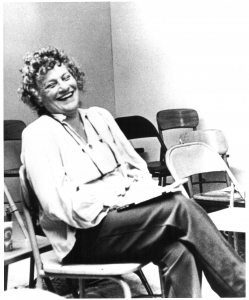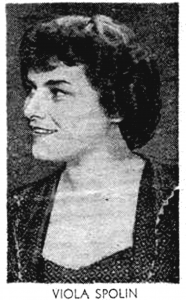 Young Viola Spolin wanted to be an actress. She left her home in Chicago and went to New York to gave it her best shot. She got no work there. She returned to Chicago and shifted her focus. In so doing, she transformed the American theater. (PS, she also finally got to act.)
Young Viola Spolin wanted to be an actress. She left her home in Chicago and went to New York to gave it her best shot. She got no work there. She returned to Chicago and shifted her focus. In so doing, she transformed the American theater. (PS, she also finally got to act.)
Most of the people in the “Innovators” series are and will be historical figures, people whom my colleagues and I will have to research. But I knew Spolin a little, and that informs my perspective.
Back in the 1970s, I spent the better part of four years working on a book called Something Wonderful Right Away, an oral history of The Second City and The Compass Players and the beginnings of the improvisational theater movement. The founding director of Second City and Compass was Paul Sills. Viola Spolin was Paul Sills’s mother, both biologically and artistically. Sills was always clear that the theatrical projects he developed rested firmly on the groundbreaking work his mother did. Naturally I wanted to interview her.
I met her in her house in the Hollywood Hills. “House” is a word that doesn’t quite do justice to what she called home. It 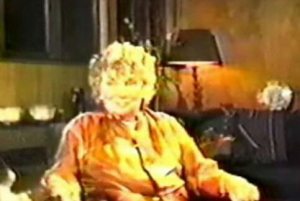 looked as if it had begun as a fairly modest structure, and then extra rooms had been built as the fancy took her, stretching outwards without much concern for architectural niceties. It struck me as a metaphor for her life – a structure that grew in spontaneous response to her interests, impulses and needs. As we talked, she radiated a peculiar blend of warmth and apprehension. She didn’t seem to like being interviewed. My hunch? She didn’t care for somebody else acting as a conduit between her and others. Rather than be interpreted by the likes of me, she would have preferred to make contact directly.
looked as if it had begun as a fairly modest structure, and then extra rooms had been built as the fancy took her, stretching outwards without much concern for architectural niceties. It struck me as a metaphor for her life – a structure that grew in spontaneous response to her interests, impulses and needs. As we talked, she radiated a peculiar blend of warmth and apprehension. She didn’t seem to like being interviewed. My hunch? She didn’t care for somebody else acting as a conduit between her and others. Rather than be interpreted by the likes of me, she would have preferred to make contact directly.
Nevertheless, I remember enjoying the conversation. I particularly recall her telling me that her love for the theater was first triggered by the Chicago Lyric Opera. Her father was a policeman, and he sometimes earned extra money working security during opera performances. A side benefit was that his young daughter got to attend some of them. Spolin spoke of sitting in the audience of a performance of La Bohème, marveling at the sight of snow falling on the stage. (Under the heading of small world, when I was a child in the Chicago area, I once was a super at the Lyric Opera, playing a student walking through snow in, yes, La Bohème. Of course, this was many, many years later.)
What Spolin didn’t tell me was that, as part of his duties on the police force, her father was a member of Chicago’s “red squad.” This was a group of cops who participated in the infamous Palmer raids, so named for United States attorney general, A. Mitchell Palmer, who suspected recent immigrants to the U.S. of un-American activities. His response: in 1919-20 he deployed squads across the country to arrest and deport hundreds, mostly without anything resembling due process. (Palmer’s disregard for the law led to a repudiation of his methods by Congress, but that’s another story.)
I think it is significant that, not long after her father harassed immigrants, young Viola chose to work with them. Specifically, in 1924-26, she chose to work at Hull House, which was founded by Jane Addams in the 19th century. Part of the mission there was to help people new to this country surmount ghettoization and join recent arrivals from other countries in the American experience. These people needed to learn new languages and customs and how to communicate across cultural and ethnic barriers, and that’s part of what Hull House did.
It was at Hull House that Viola met the woman she credited as being the greatest influence on her – Neva Boyd. Boyd recognized the value of play, not just as a respite from work, but as something essential for human development. Play builds skills in cooperation and teaches people to truly listen to each other and imagine themselves in each other’s circumstances. Boyd focused on using storytelling games – games in which the players took turns adding details to a narrative. It is important to understand that these were not games in which people won or lost, but structures for the participants to interact with each other on an equal basis. Inherent in these games was a spirit of democracy; anyone could participate, anyone could contribute. Viola served as an assistant to Boyd and much of her work builds on what she learned doing so.
The desire to pursue acting led Viola to try her luck in New York in 1931. She didn’t manage to launch her career there, but she spent much of her time studying with members of the Group Theatre.
As you may remember from Julius Novick’s Innovators portrait of Harold Clurman (one of the company’s founders), The Group in the thirties had a cache similar to that of the Steppenwolf players today; it was the troupe that a lot of idealistic young theater artists dreamed of joining. Drawing inspiration from the teachings of Russian director-teacher Constantin Stanislavski, the signature of the Group’s productions was a sense of ensemble new to the Broadway stage and an emotional intensity that gave even its productions of lesser scripts a bracing urgency. In plays like Awake and Sing and Paradise Lost, its resident playwright, Clifford Odets, wrote about the grinding effect the Depression had on human relations and blamed capitalism for the desperate state of the economic system.
Viola didn’t act in any of the Group’s productions, but she was attracted to their vision of ensemble work. She maintained ties with its members after she left New York. One of Paul Sills’s childhood memories was of Group actors Morris Carnovsky, Stella Adler and John Garfield visiting when they were passing through Chicago some years later. Later, when she was living in Los Angeles, she would get together with Group alumni when movie work brought them west.
As part of the U.S. government’s response to the Depression, the Works Progress Administration was set up to create public projects that would give employment to many. Several of the WPA initiatives involved supporting the arts. (One of these was the Federal Theatre Project, which was run by one of our other Innovators, Hallie Flanagan.) Neva Boyd recommended Viola to run a dramatic project for children back in Chicago.
By taking the position (which she held from 1939 to 1941), she began the work that would define the rest of her life. Unlike some directors working with young performers on shows, she didn’t want to impose blocking and bits of business on them. She believed that they would do better work if the solutions to dramatic problems originated out of their own imaginations. To stimulate them she returned to Boyd’s idea of playing games. She carried her mentor’s work one step farther by inventing games as she needed them.
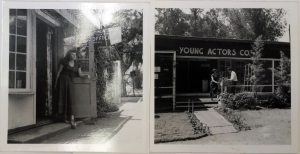 Sometimes she would have the students play scenes in gibberish so that they would have to make their dramatic points without dependence on language. This would prompt the actors to make their gestures more expressive and endow their characters with a more vivid physical life. If the actors seemed to be oblivious to the location in which the scene was set, she would have them define the “where” by doing what she called space work (mime) to create objects and activities specific to that environment. If the actors seemed inhibited, she might have them play “contact,” a game requiring each to find a logical reason to make physical contact with another player for every line spoken.
Sometimes she would have the students play scenes in gibberish so that they would have to make their dramatic points without dependence on language. This would prompt the actors to make their gestures more expressive and endow their characters with a more vivid physical life. If the actors seemed to be oblivious to the location in which the scene was set, she would have them define the “where” by doing what she called space work (mime) to create objects and activities specific to that environment. If the actors seemed inhibited, she might have them play “contact,” a game requiring each to find a logical reason to make physical contact with another player for every line spoken.
She viewed directing partly as an editorial function. She would greet a particularly happy discovery by insisting it had to be part of the final presentation. By the time the shows were ready for audiences, they would be filled with these discoveries, moments that had been created by the performers themselves. Viola believed that her young actors would present their own ideas with confidence and pride, as opposed to grudgingly doing what they were compelled to do by some overbearing adult authority figure.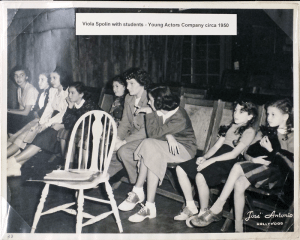
In time expanded her work to include older players. The Chicago Daily News of May 26, 1939 contains an account of a performance she supervised. The reporter observed that there were something like 150 performers from various ethnic backgrounds, and the evening they put up had been created cooperatively by them and reflected their experiences.
In one scene, an unemployed man looked through the wants ads for a job that wasn’t there. As the Daily News reported, “Into this scene comes a politician, with $5 and a basket of food. ‘Come and see me after the election,’ he says cheerily. ‘I’ll fix you up. You know I’m your friend. Have a cigar.’ … Just as the man is taking the cigar, his son comes in and knocks it out of his hand. ‘Don’t take anything from this politician,’ he says. ‘We’re not selling America for a cigar!’”
The method of developing the material came from Viola. The subject matter and the quoted line could easily have come out of one of Clifford Odets’s plays for the Group.
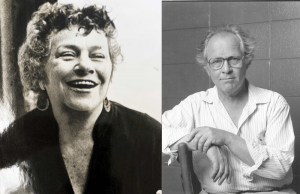 Her son Paul (who was born in 1927 and died in 2008) grew up with his mother’s games and, as he grew older, sometimes ran workshops for her. During World War II, he served in the merchant marine. Afterwards, he found himself attending the University of Chicago where he began directing fellow students in productions. The methods he used to stage these plays were drawn from what he had learned from his mom. When David Shepherd, an idealistic young man with a little spare cash in his pocket, stumbled upon Sills’s college efforts, he joined with him to start a bare-bones professional company called Playwrights Theatre Club that alternated new plays with more artsy and adventurous fare by the likes of T.S. Eliot and Bertholt Brecht. By this time, Viola had moved to Los Angeles, but she was brought back to Chicago to direct a production at Playwrights of Sean O’Casey’s Juno and the Paycock.
Her son Paul (who was born in 1927 and died in 2008) grew up with his mother’s games and, as he grew older, sometimes ran workshops for her. During World War II, he served in the merchant marine. Afterwards, he found himself attending the University of Chicago where he began directing fellow students in productions. The methods he used to stage these plays were drawn from what he had learned from his mom. When David Shepherd, an idealistic young man with a little spare cash in his pocket, stumbled upon Sills’s college efforts, he joined with him to start a bare-bones professional company called Playwrights Theatre Club that alternated new plays with more artsy and adventurous fare by the likes of T.S. Eliot and Bertholt Brecht. By this time, Viola had moved to Los Angeles, but she was brought back to Chicago to direct a production at Playwrights of Sean O’Casey’s Juno and the Paycock.
David Shepherd soon began to lose interest in putting on plays reflecting New York and European experiences and sensibilities. He wanted to present to the audiences of Chicago plays about life in Chicago. Nobody was writing these. So he decided to try to build new plays fast by soliciting outlines for stories suitable for the stage. In the days before the public performances, the actors in rehearsal would create the dialogue and the behavior. Shepherd enlisted Spolin to run weeks of workshops to train players to do this kind of work.
Spolin returned to Los Angeles before the theatre Shepherd envisioned opened, but her input was key. Shepherd was right. Spolin’s games were indeed the necessary preparation for actors to cooperatively create the stage events he envisioned. The Compass Players opened on July 5, 1955 with a long one-act play developed improvisationally under Sills’s direction from an outline he had whipped up called The Game of Hurt. It was the first ongoing professional improvisational theatre, and it launched such major talents as Mike Nichols, Elaine May, Shelley Berman and Barbara Harris.
The haphazard nature of the Compass eventually evolved, in December 1959, into the more disciplined and polished revues of Second City, of which Sills was the first director. As co-producer, Sills hired his mother to return to Chicago and help train many of his new gang. Working with these actors, and with his son’s encouragement and editorial input, she composed a book articulating her philosophy and methods. Titled Improvisation for the Theatre, it was published by Northwestern University Press in 1963 and has gone through dozens of printings since.
At one point, somebody decided to release a box containing hundreds of cards on each one of which was printed a theatre game. The release was a violation of her copyright and she managed to get the box withdrawn. But she recognized the idea of putting games on cards had value, and Northwestern subsequently published an authorized edition.
The movement she began ultimately led to scores of performers finding major careers via Second City as comic actors on stage, in film and on TV, but those reading her book for a guide on how to get into the cast of Saturday Night Live will search in vain. She wasn’t looking to develop professional funny people but to create vital, honest life onstage through a shared reality.
Some of the later talents associated with Second City downplayed her influence. Del Close, one of the best-known improvisational directors and theorists, sometimes casually disparaged her work as being “for kids.” However, late in our friendship, I remember him saying ruefully, “I was looking at her book for the first time in years the other night, and *&?%*!, she really did get there ahead of the rest of us.”
I edited a chapter based on the interview I did with Viola in her house in the hills, but she pulled a switch on me. She decided not to sign the permission form to let me publish it in Something Wonderful. When I asked her why, she said, “Oh, honey, people have been making money on me all my life, and I’ve decided to draw the line.” I tried to persuade her that she was drawing the line in the wrong place. I was never going to make serious money out of my book, but she held fast. She would not and did not sign the form, and her chapter did not appear.
But, of course, she was in the book. She had touched many of the people I interviewed, and they couldn’t help but speak of her influence on their lives.
Some years after my book came out, I was in Los Angeles attending a performance of Sills and Company, an evening of theatre games played by players who had worked with Paul Sills over the years. I visited backstage before the show, and there was Viola. She spotted me and swept over. “Oh, Jeff, do you hate me?” Naturally I told her I didn’t, and I was telling the truth. We hugged and kissed, and that was the last time I saw her. Her work had transformed my life. Most of my ideas about the theoretical underpinnings of the theatre have their roots in her explorations.
Viola conducted workshops for most of the rest of her life, and lived to see herself given the place of honor she deserved. She died in 1994, and at a memorial held in Los Angeles, dozens of actors (some of whom she had never met) gathered to play the games in her memory. Part of her legacy is that there is no major city that doesn’t host at least one troupe of improvisers, and hundreds of smaller towns and universities do as well.
But I must acknowledge that Viola was right to be jealous of her work. There are dozens of books published that claim to teach the principles of improvisation, and quite a few of them don’t bother to mention her name. Some of this is probably just sloppiness, but some of this is outright conscious appropriation of her intellectual property.
Before she left us, she did finally realize one of her dreams. Paul Mazursky, who had been a member of a Los Angeles Second City company, wrote and directed a 1970 movie called Alex in Wonderland about a Hollywood movie director in a state of confusion. The director was played by Donald Sutherland and his smart, confrontational mother was played by Viola Spolin. In a fantasy sequence she got to dress in an extravagant costume and ride a white horse.
Recommended reading, viewing, and listening
Books
Viola Spolin’s signature work, commonly viewed as the bible of improvisational theatre theory, is Improvisation for the Theatre (Northwestern University Press). Originally published in 1963, it went through three subsequent editions (with input from her son Paul Sills and Sills’s wife Carol), but the heart of it has remained constant – the collection of theatre games she created in response to the needs of the actors she worked with over the years. Northwestern also publishes her other titles: Theater Games for the Classroom: A Teacher’s Handbook, Theater Games for the Lone Actor, and Theater Games for Rehearsal: A Director’s Handbook.
Film
As mentioned, Spolin has one significant part as an actor in Paul Mazursky’s Alex in Wonderland. It is not released on DVD, but there are occasional sightings of the VHS for sale online. Perhaps your local library has a copy.
I have been able to find only one on-camera interview with Spolin online.
